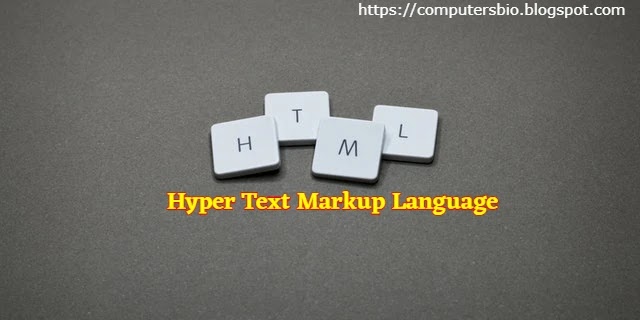Introduction
Hyper Text Markup Language is the most important aspect in website development. We write web pages that mainly contain code in this language. As the name indicates, it is also like other high level languages. But learning it is relatively easy compared to other high level languages.
 |
| Hyper Text Markup Language |
Concept of Hyper Text Markup Language
HTML There is a simple computer language which we can also call a page description language. It contains a set of codes that determines how a web page will look in the browser. H. T. M. L. It is an abbreviation for Hyper Text Markup Language.
Hypertext is a special type of text. It is not sequential like the contents of the book. Just as we want to see any information in a book quickly, then we go to the index of the book and see that information. That's how hypertext works. You can associate words and pictures with other pages and when you select those words and pictures it will take you to that particular page. This hyper (licking) is the mainstay of the wave.
The term markup originated from the field of printing. It is meant to tell the typesetter how to place text and images on the page to be printed. It contains instructions regarding font, character size, white spaces on the page. H. T. M. L. Almost everything works the same way, only the type-setter has been replaced by the browser. In other words, HTML It is the language that tells the browser how to display hypertext on the computer screen.
Versions of HTML
HTML After its development till now many versions have been available in the market which are as follows:
1. HTML 2.0 - It was created under the patronage of IETF (Internet Engineering Task Force). It was put into use in 1994.
2. HTML 3.0 - This version was richer than HTML 2.0, but changed with new threads each time due to lack of standard decision making.
3. HTML 3.2 - This version came into use in 1996 after some favorable efforts.
4. HTML 4.0 - This version of HTML is used with new functionality. These are various activities - scripting frames, tables, forms, style sheets and convenience for common people to use.
H. T. M. L. Editors
H. T. M. L. Documents are simple text files also known as ASCII (ASCII). It can be created with the help of any text editor. There are different types of editors available in the market for different platforms. For example, Emacs for Unix or B. I. (VI), Simple Text for Macintosh, Notepad for Windows are used.
You can also use word processing software if you can remember to save your document as text only with line breaks. Some what-you-see-is-what-you-get editors are also available, such as the home page or Adobe page Mill for both Windows and Macintosh.
You can test any of this if you have learned some basic H.T.M.L. Tagging is learned. What-you-see-is-what-you-get means that you can access your H.T.M.L. Directly design the document. W. why. s. I. W. Y. Yes. (WYSIWYG) is similar to using a word processor.
In this type of editor, instead of writing markup tags in a normal text file, you can format text and design web pages with the help of various tools and menus. All W,Y. s. I. W. why. Yes. Editors may not necessarily support the desired features. In such a situation, H. T. M. L. is used to code those features. information is useful.
HTML of Elements
HTML HTML Element A basis of the document consists of Heads, Tables, Paragraphs and Lists. Elements are parts. Examples of elements can include plain text in the handle, other elements, and both.
Tags
Every web page is made up of several elements. These elements are HTML displayed by code. These elements are called tags. Tags are always enclosed in angle brackets (<>). Tags are usually available in pairs, opening and closing. A closing tag is similar to an opening tag, but begins with a forward slash (/).
Format : <Tagname> </Tagname>
Example : <P> ...... </P>
Attributes
a user (who is using HTML) This Specifies how a web browser should use the tag. Except for the end tag, the start tag can contain attributes.
Format : Attribute="value"
Example : align="center"
Also Read :
- What is Charles Babbage Analytical Engine?
- What is a computer simple definition?
- What's the meaning of Windows XP?
- What is a database in computer?
- What is computer desktop publishing (DTP)
- What is distributed system explain?
- What is Internet easy definition?
- What are the features of page layout software?
- Short note on Blaise Pascal and Pascaline







0 Comments
Please do not enter any spam link in the comment box.